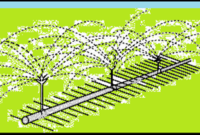In the sprinkler technique of irrigation, water is sprinkled into the air and allowed to fall on the ground surface just like rainfall. The spray is done by the flow of water under pressure through small orifices or nozzles. The pressure is generally obtained by pumping. Through proper selection of nozzle sizes, operating pressure and sprinkler spacing the amount of irrigation water required to refill the crop root zone can be applied almost uniform at the rate to suit the infiltration rate of soil. In agriculture, almost all crops are suitable for sprinkler irrigation system except crops such as paddy and jute. The dry crops, vegetables, flowering crops, orchards, plantation crops like tea, coffee are all suitable and can be irrigated through sprinklers techniques of irrigation.
The sprinkler irrigation is categorized according to the functions which are mentioned as under:
1. The main irrigation system
2. The supplementary irrigation system
3. The protective irrigation system
The sprinkler irrigation system is effective for irrigation on uneven lands and on shallow soils. It is also suitable to coarse sandy terrain where the percolation loss is more and where as a consequence, the frequency of irrigation required is more. The sprinkler irrigation system is appropriate in rising and falling land where land shaping is expensive or technically not practicable. The elimination of fertile soil cover by land shaping is not advisable. Sprinkler irrigation system can also be espoused in hilly regions where plantation crops are grown.

Historical facts signified that though sprinkler irrigation system is known since 1946, yet the farmers started adopting it in huge scale only since 1980s. It began in the hilly areas of Western Ghats in states of Kerala, Tamil Nadu and Karnataka and in the North eastern states mainly for plantation crops like coffee, tea, cardamom, rubber. Gradually it spreads to the water scarcity and light soil states of Rajasthan and Haryana in addition to the black soil area of Madhya Pradesh.
Advantages of sprinkler irrigation:
- Elimination of the channels for conveyance, therefore no conveyance loss.
- It is Suitable to all types of soil apart from heavy clay.
- It is appropriate technique for irrigating crops where the plant population per unit area is very high. It is most suitable for oil seeds and other cereal and vegetable crops.
- It saves water.
- With this technique of irrigation, there is control of water application convenient for giving light and frequent irrigation and higher water application efficiency.
- Sprinkle irrigation increases in yield.
- There is a mobility of system.
- It may also be used for undulating area.
- It saves land as no bunds are required.
- This technique influences greater conducive micro-climate.
- Areas located at a higher elevation than the source can be irrigated.
- In this technique there is a possibility of using soluble fertilizers and chemicals.
- In this method of irrigation there is less problem of clogging of sprinkler nozzles due to sediment laden water.
- The overall cost of labour is generally reduced in this method of irrigation.
- Erosion of soil cover which is common in surface irrigation can be reduced.
Disadvantages of sprinkler system:
- In this technique, initial cost of implementation is high.
- High and constant energy requirement for operation.
- Under high wind condition and high temperature distribution and application efficiency is poor.
- Highly saline water causes leaf burning when temperature is higher than 95 F.
- When lands have been already levelled and developed for surface or other irrigation methods sprinkler irrigation is not so economical.
- There is loss of water due to evaporation from the area during irrigation.
